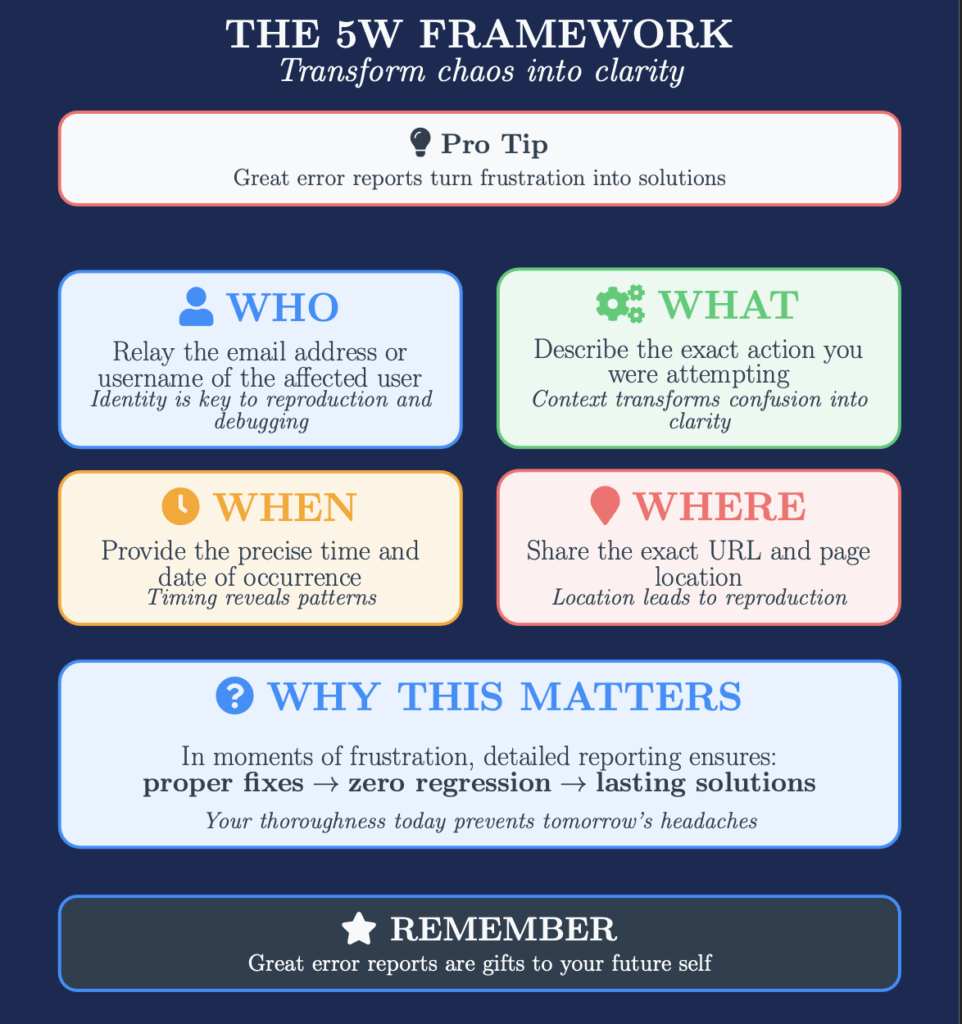
You know the moment. You’re in a groove writing code, and Slack pings: “The checkout thing glitched out again.” You ask what happened, but the reply is either silence or “I don’t know, it just doesn’t work.”
That’s the reality of most bug reports. They often land in one of a few predictable shapes:
- The Vague Reporter: “The app is being weird.” No specifics, no details.
- The Screenshot Bomber: A picture of a 500 error page, nothing else.
- The Frustrated Deflector: Annoyed you’d even ask questions. “Isn’t this your job?”
- The Panic Reporter: “Everything is broken.” Spoiler: it isn’t.
None of this is malicious. Most people simply don’t know what information matters. But the impact on developers is the same: hours spent guessing, context switching, and sometimes giving up on bugs that can’t be reproduced.
After too many of these dead ends, I started noticing a pattern. The best bug reports all answered the same set of questions. It reminded me of journalism’s who, what, when, where, why. That’s where the “5W Framework” came from—not as some polished methodology, just a shorthand for what makes a bug report actually useful.
The 5W Breakdown
- Who. Which user or account? Permissions, data, and configurations are often the trigger.
- What. What were they doing? “It broke” is useless. “Clicked ‘Save’ on a form with 50+ characters” is gold.
- When. Exact time matters. It lets you match up errors with logs, deployments, outages.
- Where. Which page, URL, or screen? Different parts of the app mean different code paths.
- Why. The messy one. Sometimes it’s just extra context: it started after a deployment, only affects mobile, or only one payment method fails. Even partial guesses help.
It’s amazing how much smoother debugging goes when these five questions are answered.
A Before and After
Before:
checkout glitched out
[screenshot of 500 error]
That leads to a 20-minute back-and-forth just to piece together what actually happened.
After:
Payment error, User ID 12847
WHO: sarah.martinez@company.com
WHAT: Tried $89.99 Visa purchase, clicked “Complete Order,” got “processing failed.”
WHEN: Jan 15, 2:23 PM PST
WHERE: /checkout/payment
WHY: Card worked last week, issue started today.
That’s a totally different starting point. You can actually do something with it.
Why This Matters
For me, the 5W idea isn’t about “best practices” or “rolling out a framework.” It’s about survival. If you don’t get the right details, you waste hours chasing shadows. If you do, the whole process changes: debugging turns into pattern recognition, not guesswork.
Over time, you even start to see trends. Payment issues always spike after gateway maintenance. Mobile users keep hitting the same broken form. Those kinds of patterns only show up when the reports are structured.
I don’t think this fixes the reporting problem completely. Users will still send vague complaints, screenshots without context, or full-caps EVERYTHING IS BROKEN. But having this mental checklist has saved me countless hours.
At the very least, when I’m the one filing the bug, future-me has something to work with.